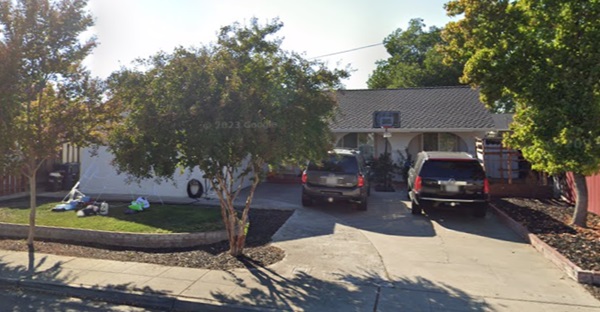H. C. Elliott’s Town Square Series in Livermore (1964–1967): the village that landed
A historical tour of Town Square, Livermore (1964–1967)
Explore H.C. Elliott's Town Square Series in Livermore through vintage 1964–1967 newspaper ads and see what the original model homes look like today. Built in the Town Square neighborhood, the Town Square Series laid the groundwork for replacing an old airport with a new neighborhood. A curated archive for fans of 1960s–70s architecture, suburban design, and East Bay history.
Welcome to Town Square, 1964–1967
In the early 1960s, Santa Barbara builder H.C. Elliott landed in Livermore with a vision—and a bulldozer. Where others saw a shuttered airport, Elliott saw a village waiting to happen. Not just streets and houses, but a whole community: parks, schools, shopping, and homes priced so attractively, first-time buyers felt like they'd hit the jackpot. The result was Town Square—a master-planned neighborhood for the every-family dream.
 |
| Location of the Town Square neighborhood in Livermore, California. H. C. Elliott would continue to build in the adjoining Somerset neighborhoods. |
Elliott crafted a neighborhood built for modern life—functional, attractive, and comfortably within reach. And when Town Square held its grand opening on June 21, 1964, families lined up to see the promise of a better life, wrapped in stucco and asphalt shingles. Prices started at $14,950, which meant you could actually afford to live near a new freeway and still have a backyard for the dog.
Homes that felt like a splurge, but came with a price tag that didn’t
Elliott’s goal was clear: to offer realistically priced new homes that could comfortably fit any-sized family.
 |
| From a 1964 Oakland Tribune–the crown jewel of Town Square—a smartly designed, spacious home that proved big didn’t have to mean out of reach. |
Affordability didn’t mean sacrificing style. Inside, walnut wall paneling added warmth and richness, while unique baluster room dividers brought a touch of airy elegance—separating spaces without closing them off. Some homes even included walk-in closets and sunken living rooms.
 |
| From a 1964 Oakland Tribune–mid-century cool meets everyday charm—Elliott’s signature wood balusters brought style and subtle separation to Town Square living rooms. |
The model homes of Town Square
Opened in June 1964, 6 model homes were shown on Cayuga Drive, near Pine and Rincon. With models being added or retired through 1967, up to 10 floor plans were built in Town Square.
 |
| Site of the Town Square model homes. |
Pricing history
- 1964: $14,950 - $21,950
- 1965: $14,950 - $20,900
- 1966: $15,725 - $23,950
- 1967: $18,200 +
Model homes
1. The Monterey - 4 bedrooms, 2 bathrooms, 1,296 - 1,333 sq. ft.
2. The Plan 2 - 3 bedrooms, 2 bathrooms, 1,144 sq. ft.
3. The Arcadian - 2 bedrooms, 1 bathroom, 910+ sq. ft. Versatile and tidy, often tucked onto corner lots with garages at playful angles.
4. The Plan 4 - 4 or 5 bedrooms, 3 bathrooms, 1,572 sq. ft. Ambitious but not terribly popular. Retired by 1966.
5. The Newporter - 3 bedrooms, 2 bathrooms, 1,282 sq. ft. Cozy with room for comfort—and coffee on the porch.
6. The Plan 6 - 4 bedrooms, 2 bathrooms, 1,697 sq. ft. Big families, this was your floor plan.
7. The Jamaica - 3 bedrooms, 2 bathrooms, 1,559 sq. ft. A solid mid-size home with a little flair.
8. The Catalina - 4 bedrooms, 3 bathrooms, 1,800 sq. ft. Added in February 1966.
 |
| From a 1966 Oakland Tribune–to be appreciated, one had to see it with the original garage door. |
9. The Danville - 4 bedrooms, 3 bathrooms, 1,700 sq. ft. Arrived in April 1966, ready to impress.
10. The Barcelona - 4 bedrooms, 2 bathrooms, 1,588 sq. ft. Added in February 1966.
Town Square today
Here's what the Town Square model homes look like in 2024.
The Monterey today
 |
| The original Monterey model today. |
The Plan 2 today
 |
| The original Plan 2 model today. |
The Arcadian today
 |
| The original Arcadian model today. |
The Plan 4 today
 |
| The original Plan 4 model today. |
The Newporter today
 |
| The original Newporter model today. |
The Plan 6 today
 |
| The original Plan 6 model today. |
The Jamaica today
 |
| The original Jamaica model today. |
The Catalina today
 |
| The original Catalina model today. |
The Danville today
 |
| The original Danville model today. |
The Barcelona today
 |
| A Barcelona home (not original model). |
A place to begin, and a place to belong
Town Square wasn’t just another subdivision—it was proof that first-time homebuyers didn’t have to settle. Style, comfort, and a proper address were suddenly within reach. The homes were modest but smartly designed, and the prices stayed grounded even as aspirations soared. From that dream, a real village took shape—leafy streets, schools, neighbors, and a sense of arrival.
By the end of 1967, all 412 homes were complete. And with a successful track record—even in an era of tight money—H.C. Elliott turned his sights to the next chapter, across the old airport runway.
Related post: H. C. Elliott's old Livermore airport





Comments
Post a Comment